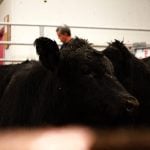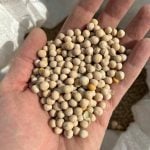During the first half of October, Alberta packers were buying fed cattle on a dressed basis at average prices of $390/cwt. Live prices f.o.b the feedlot in southern Alberta were quoted at $233/cwt. The Alberta fed cattle market was unchanged from 30 days earlier.
Market-ready supplies in the U.S. will tighten during the fourth quarter of 2023 and first half of 2024. However, in Western Canada, market-ready fed cattle numbers will be above year-ago levels during the first quarter of 2024. The net result will be a yearly decline in Canadian and U.S beef production.
Despite that decline, demand is also decreasing. There are economic indicators that suggest consumer spending peaked in late July and early August. Consumers on both sides of the border are contending with lower disposable income, which will result in lower spending on leisure, travel and entertainment.
Read Also

Harvest wraps up and fall work begins
At the Eppich famly ranch in western Saskatchewan, the fall harvest was successful with few breakdowns, cows and calves have been sorted and a new tractor has arrived
The feeder market is in a unique situation. While beef demand is easing, feeder cattle markets in Western Canada continue to trade at historical highs. The cattle industry is bracing for significant heifer retention in the latter half of 2024, which is causing the August 2024 feeder cattle futures to trade at a sharp premium to the nearby November 2023 contract. Feed grain prices appear to be making seasonal lows and the Canadian dollar tends to trade sideways to lower during the fall period.
The USDA Cattle on Feed Reports show the placements by weight category. Doing simple math, analysts can project the number of cattle that will be ready for slaughter each month. The Commitment of Traders Report provides an indication of how much of the cattle supply is secured by the packer.
Data over the past quarter suggest that packers are only processing the cattle available. U.S. carcass weights are similar to last year. In Western Canada, market-ready fed cattle supplies are expected to exceed year-ago levels from January through March by 20,000 head each month. Feedlot placements are higher than expected during the fall period.
Production numbers down
Looking at the U.S. quarterly beef numbers (see below), we have the USDA’s quarterly production estimate. In addition to the year-over-year decline in steer and heifer supplies, the U.S. beef cow slaughter will be down by 50,000 to 60,000 head each month. U.S. first-quarter beef production for 2024 is expected to come in at 6.335 billion pounds, down 486 million pounds. U.S. 2024 second-quarter output is projected to be down 395 million pounds.

Despite the lower production, this may not result in higher fed cattle prices. Earlier in summer, analysts were expecting U.S. third-quarter GDP to finish in the range of 5.5 to 6.0 per cent (quarter-over-quarter, seasonally adjusted annual rate) Recent forecasts are now in the range of 3.0 to 4.0 per cent. More importantly, U.S. fourth-quarter GDP is expected to drop to 2.0 per cent and continue to fall to 1.0 per cent in the first half of 2024. U.S. economic growth is slowing and consumer confidence reflects a sharp drop in spending over the next six to 12 months. This will result in lower demand. Disposable income has potential to decline in the first half of 2024.
The U.S. and Canadian cow-calf producers are in the process of expanding the herd. Our contacts south of the border suggest that U.S. heifers for beef cow replacement on Jan. 1, 2024 will be up about 300,000 head from a year earlier. More importantly, early forecasts have a heifer retention up 500,000-600,000 head on the Jan. 1, 2025 inventory report.
In Canada, we’re expecting a 20,000 -30,000 head year-over-year increase in heifer retention on Jan. 1, 2024 and Jan. 1 2025. Feedlot margins will be squeezed in the latter half of 2024. Feeder cattle supplies will be extremely tight and the fed cattle market will be declining due to lower beef demand.
Cow-calf producers and backgrounding operators need to alter your marketing and production strategy. You can’t have the same strategy in 2023/24 as you had in 2021/22. The feeder market is topping out. Cow-calf producers should sell their 2023 calves in January or February 2024. This is when feedlot margins will be most favourable.
At the same time, backgrounding operators should shy away from the featherlight calves. We would recommend buying calves over 575 pounds for a hold of only three or four months. When the market is at historical highs and the interest rates are at current levels, backgrounders need to have shorter turns. The market is extremely vulnerable to downside risk. Make sure you have price insurance on all your cattle. We’ve been advising finishing lots to make sure the bulk of the cattle in the lot are forward contracted.
















